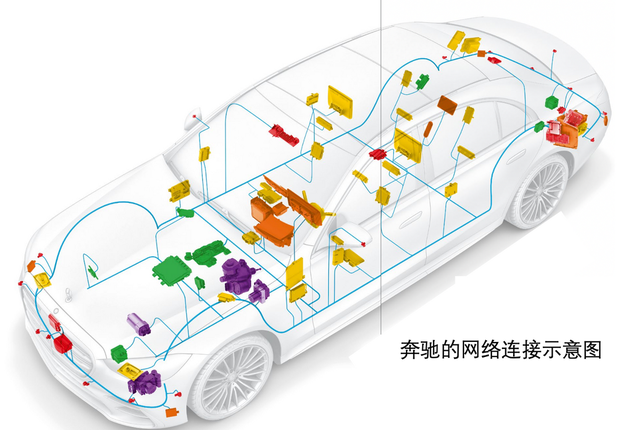Author: Zhu Yulong
Recently, I have read two articles about Mercedes-Benz’s EE architecture STAR3 and the related 12V power distribution system design – “STAR3 – Eine neue Generation der E/E-Architektur” and “Mercedes ‘S-Class’ Powernet Architecture”. I want to explore the Mercedes-Benz EE architecture systematically based on these two articles.
As early as 2020, Mercedes-Benz completed the production of Domain architecture, which uses Ethernet in four areas: power, body, entertainment, and automatic driving assistance, and combined with CAN-FD, Automotive Ethernet (100BASE-T1), HSVL2.0 (high-speed video link), and HSDL (high-speed data link) technology combination.

Mercedes-Benz has upgraded Ethernet and high-speed connections to meet higher bandwidth and scalability requirements, and has implemented wireless OTA updates with information security measures. In the power architecture, a dual-battery system design is used to provide redundant power supply for key components, as shown in the following figure, including 48V battery (including DC-DC) and 12V AGM, combined with multiple 12V power distribution boxes, and many power distribution structures are designed.

Mercedes-Benz’s STAR3 EE Architecture
Mercedes-Benz first introduced the STAR 3 next-generation E/E architecture in the new S-Class (BR 223), integrating numerous functional innovations, and then extended this E/E architecture to other products, with great compatibility. The highlights of this STAR3 architecture are:
-
Domain-oriented architecture: Developed domain controllers and gateways to decouple domains from Ethernet backbone networks
-
Introduction of CAN-FD and 100BASE-T1 Automotive Ethernet: Creating bandwidth reserves with competitive costs
-
The use of service-oriented communication concepts on Automotive Ethernet (SOME/IP, client/server communication (C/S)): To achieve more flexible domain decoupling and support the development cycle of individual components.- Import Mercedes-Benz Remote Services: Over 50 electronic components in the vehicle can be updated via OTA
-
Multi-level security design concept for ensuring safety: External vehicle access, secure onboard communication, and hardware security module in vehicle ECU

Design Considerations for High-Speed Communication Bandwidth
Previously, Mercedes’ onboard network mainly included LIN, CAN, FlexRay, MOST150 (Media-Oriented Systems Transport), and HSVL for vehicle networking. The new S-Class is based on CAN-FD, Ethernet in the car (100BASE-T1), and HSVL2.0 extensions.

The various uses include:
(1) Audio data
Used to synchronize the audio data and sound systems between entertainment system hosts (HU) using the MOST150 bus. The bandwidth of 150 Mbit/s supports all audio channels of the sound system for delay-free transmission with the highest quality.
(2) Video data
The need for bandwidth is continuous in the field of video transmission, driven by the increasing display size and resolution. HSVL2.0 covers all current display requirements with bandwidths in the range of several gigabits. Enabling a transfer rate of up to 6 GBit/s, higher transmission bandwidth supports special algorithmic visual lossless compression (VESA DSC) software use. HSVL2.0 also supports coaxial cable power supply (the connection of the reversing camera does not require a separate power supply for the camera).
HSVL2.0 provides camera and display with the use of other data formats over the same physical encoding (sideband channel). It is used for gigabit Ethernet channels, quick transmission of information between the system host and the instrument panel, an I2C channel connecting the touchscreen and the system host, and an Ethernet channel used for haptic feedback. It provides an HSVL2.0 mechanism for end-to-end protection of video transmission, such as the image of the rearview camera.

(3) High-Speed Data Link (HSDL)
The field mainly focuses on fast and high-performance data channels for remote information networking in entertainment systems, supporting high-bandwidth communication requirements, content sharing between different control units in vehicles, and online streaming media. It enables output and telephone voice of lossless audio quality through mobile networks, with a maximum of 1 GBit/s.
Currently, the high-speed data link HDBaseT technology is a symmetrical connection that meets automotive standards with a bandwidth of 2 GHz. It acts as a local tunnel for Gigabit Ethernet, USB 2.0, and I2S (audio bus) with low latency <30us.
The possible cable length of USB can be increased from 5 meters to 15 meters, with diagnosed integration of HDBaseT link (monitoring cable breaks and shorts).

In summary, the application of Ethernet by Mercedes-Benz will be discussed in the following part, and I believe that taking the time to read these will help us understand the development and evolution of the entire EE architecture. I will write the second half tomorrow.
This article is a translation by ChatGPT of a Chinese report from 42HOW. If you have any questions about it, please email bd@42how.com.
